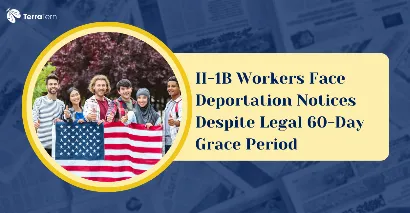Key Highlights
A growing crisis has emerged for H-1B visa holders in the United States, as many laid-off workers are receiving Notices to Appear (NTAs) for deportation proceedings even while they remain within their legally protected 60-day grace period. This has put most of the skilled foreign workers at risk of being deported, with many feeling lost and scared because they had been having the wrong view on the immigration rule, having been doing things the right way.
Also Read: H-1B Visa: Explore Your Options for A Job Switch In The US
Understanding the 60-Day Grace Period
When the H-1B employees are terminated, the federal rules offer a grace period of 60 days, enabling them to secure new jobs elsewhere, alter their existing visa status, or make appropriate plans to leave the country. This cushion has acted as a safety net for skilled workers who face unexpected layoffs in the turbulent tech sector.
The grace period commences the day after the final day of employment and is meant to give the workers enough time to:
-
Transport their H-1B status and classify it to a different employer
-
Request to switch to the new categories of visas
-
October 6: Make plans to leave the United States willingly
The Current Crisis: NTAs During Grace Period
An immigration attorney by the name Sameer Khedekar of Vanguard Visa Law says that the Department of Homeland Security is getting more and more aggressive in sending NTAs to immigration courts, even in situations where an H-1B employee has change of status applications in the pipeline, and has been laid off. These notifications indicate the date the previous employer has withdrawn the H-1B visa and that the individual has overstayed their allowed period in such a country.
Statistics Behind the Crisis
Recent USCIS disclosures reveal alarming numbers:
|
Period |
Weekly NTA Issuance |
Total Since February 2025 |
|
February 2025 - Present |
1,840 NTAs per week |
Approximately 29,440 NTAs |
According to legal experts, most of these cases entail people who do not violate USCIS rules and regulations in any way.
Policy Confusion and Violations
The current situation directly contradicts USCIS policy guidance issued on February 28, 2025, which states that NTAs should only be issued "upon issuance of unfavourable decision on a benefit request" where the individual is not lawfully present. According to Rajiv S. Khanna, an Immigration attorney of Immigration.com, recent instances indicate that NTAs are being issued early to persons in legal statuses of stay.
What Makes This Situation Unprecedented
The main problem is the time. NTAs are getting served:
-
Before USCIS comes up with decisions regarding pending applications
-
While workers remain in a legally recognised "authorised stay"
-
To those who have just complied with all the mandatory practices
-
The 60-day period used to avoid such a scenario in the first place happens during the protection timeframe.
Also Read: H-1B Cap Reached for FY 2026: What’s Next for Applicants?
Impact on H-1B Workers and Families
The implications are much more significant than on the employee level. A good number of people on H-1B visas have:
-
Built strong connections within the community after living in a place
-
The children born to U.S parents are Americanized citizens, having been born to American parents who are citizens of the United States of America.
-
Mortgaging commitments and property purchase
-
The dependent relatives on associated visa types, spouse, and family members
Legal Implications of NTA Issuance
Once an NTA is issued and filed in immigration court, several serious consequences follow:
|
Consequence |
Impact |
Duration |
|
Deportation proceedings begin |
Immediate legal jeopardy |
Until case resolution |
|
Considered unlawfully present |
Affects future immigration benefits |
Potentially permanent |
|
Visa application restrictions |
Limited re-entry options |
3-10 years, depending on circumstances |
Also Read: How Many Types of Visa in USA? New Full Expert Guide
DHS Discretionary Authority
Although the 60-day grace period is in regulation, the discretion remains with the Department of Homeland Security to deny or abbreviate this period on a case-by-case basis. Nevertheless, immigration lawyers believe it is beyond a reasonable exercise of this power that NTAs are issued wholesale today.
The regulation states that DHS will determine whether "facts and circumstances warrant shortening or refusing the 60 days." Still, the current practice applies this broadly rather than on individual merit.
Industry-Wide Effects
The problem is that the tech industry has been struggling with massive layoffs already, and now it can face even more issues:
-
Challenges associated with the retention of international talent
-
Decreased acceptance of H-1B workers to take up the positions
-
The prospect of brain drain causes workers to look elsewhere for work.
-
Higher legal expenses for firms that want to maintain their valuable employees
What H-1B Workers Can Do?
Nevertheless, the immigration lawyers advise taking several protective measures despite the adverse conditions:
-
Put things in writing: Bear documentation of every application, the dates of termination of employment, and communications
-
Get legal advice: This is paramount when dealing with NTAs, as the advice of a professional will come in handy
-
Obey the due process: Submit all the necessary applications in time:
-
Avoid traveling: Grace periods should not be used to traverse international borders, as it makes reentry difficult
Also Read: Nursing Jobs in USA: Experts' Latest Jobs & Salaries
Call for Policy Clarification
Law firms that specialise in immigration across the nation are urgently requesting USCIS to take action, and they claim that the erroneous issuance of visas in legitimate stay phases needs to be addressed. This conflict between written policy and enforcement practice has left hundreds of thousands of skilled workers and their families in an intolerable situation. Deportation notices on H-1B workers can be considered the new immigration enforcement trend, and it is not only the people employed who will bear the brunt of this, but also the competitiveness of the U.S. economy and its innovation ability. With firms finding it more challenging to keep hold of overseas talent, and employees hungrier than ever in a state of uncertainty, a steady and reasonable application of immigration policies is more in demand than ever.
To stay updated about the latest immigration news, contact TerraTern right away!








